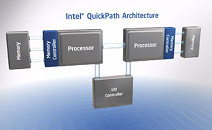- Joined
- Oct 9, 2007
- Messages
- 47,508 (7.49/day)
- Location
- Hyderabad, India
| System Name | RBMK-1000 |
|---|---|
| Processor | AMD Ryzen 7 5700G |
| Motherboard | ASUS ROG Strix B450-E Gaming |
| Cooling | DeepCool Gammax L240 V2 |
| Memory | 2x 8GB G.Skill Sniper X |
| Video Card(s) | Palit GeForce RTX 2080 SUPER GameRock |
| Storage | Western Digital Black NVMe 512GB |
| Display(s) | BenQ 1440p 60 Hz 27-inch |
| Case | Corsair Carbide 100R |
| Audio Device(s) | ASUS SupremeFX S1220A |
| Power Supply | Cooler Master MWE Gold 650W |
| Mouse | ASUS ROG Strix Impact |
| Keyboard | Gamdias Hermes E2 |
| Software | Windows 11 Pro |
Intel's Core i7 processor in the LGA1366 package is currently leading in the performance front, some of the fastest processors for the desktop platform fall in this league. Despite lacking a directly competitive processor, the platform had its share of competition thanks to motherboard manufacturers competing within themselves. EVGA for one, is set to unveil a bleeding-edge motherboard later this year, which supports two LGA1366 processors. So far, enthusiasts working for EVGA have only disclosed that the motherboard would work with Intel's DP Xeon 5000 series LGA1366 processors, which are officially capable of working on dual-socket server and workstation motherboards.
However, a plausible rumor doing rounds has it that EVGA may attempt to make its motherboard work with Core i7 series processors - which are incapable to operate in pairs, at least from what we're led to believe. EVGA is attempting to do this by modifying the reference Intel design for the platform.
To begin with, Intel with use the 5500 series IO hub instead of X58 Express. A BIOS modification on the QuickPath Interconnect routing table will connect Processor1 to Processor2 via the IO hub, in absence of a physical QPI link between the two CPU sockets (enabled on the Xeon DP processors). This approach, while making the setup possible, also increases system interconnect latencies almost two-fold.

The approach could cut platform costs at a theoretical performance penalty, letting you use Core i7 or the cheaper Xeon UP processors. Use of Xeon DP processors could then still make for a good buy, if performance at any cost matters. Much like Intel's previous attempt at a dual-socket capable processor from the Core family (Core 2 Extreme QX9775), a real DP capable Core processor cannot be written off.
There is no comment yet from EVGA, in this regard.
With inputs from Semi-Accurate.
View at TechPowerUp Main Site
However, a plausible rumor doing rounds has it that EVGA may attempt to make its motherboard work with Core i7 series processors - which are incapable to operate in pairs, at least from what we're led to believe. EVGA is attempting to do this by modifying the reference Intel design for the platform.
To begin with, Intel with use the 5500 series IO hub instead of X58 Express. A BIOS modification on the QuickPath Interconnect routing table will connect Processor1 to Processor2 via the IO hub, in absence of a physical QPI link between the two CPU sockets (enabled on the Xeon DP processors). This approach, while making the setup possible, also increases system interconnect latencies almost two-fold.

The approach could cut platform costs at a theoretical performance penalty, letting you use Core i7 or the cheaper Xeon UP processors. Use of Xeon DP processors could then still make for a good buy, if performance at any cost matters. Much like Intel's previous attempt at a dual-socket capable processor from the Core family (Core 2 Extreme QX9775), a real DP capable Core processor cannot be written off.
There is no comment yet from EVGA, in this regard.
With inputs from Semi-Accurate.
View at TechPowerUp Main Site











